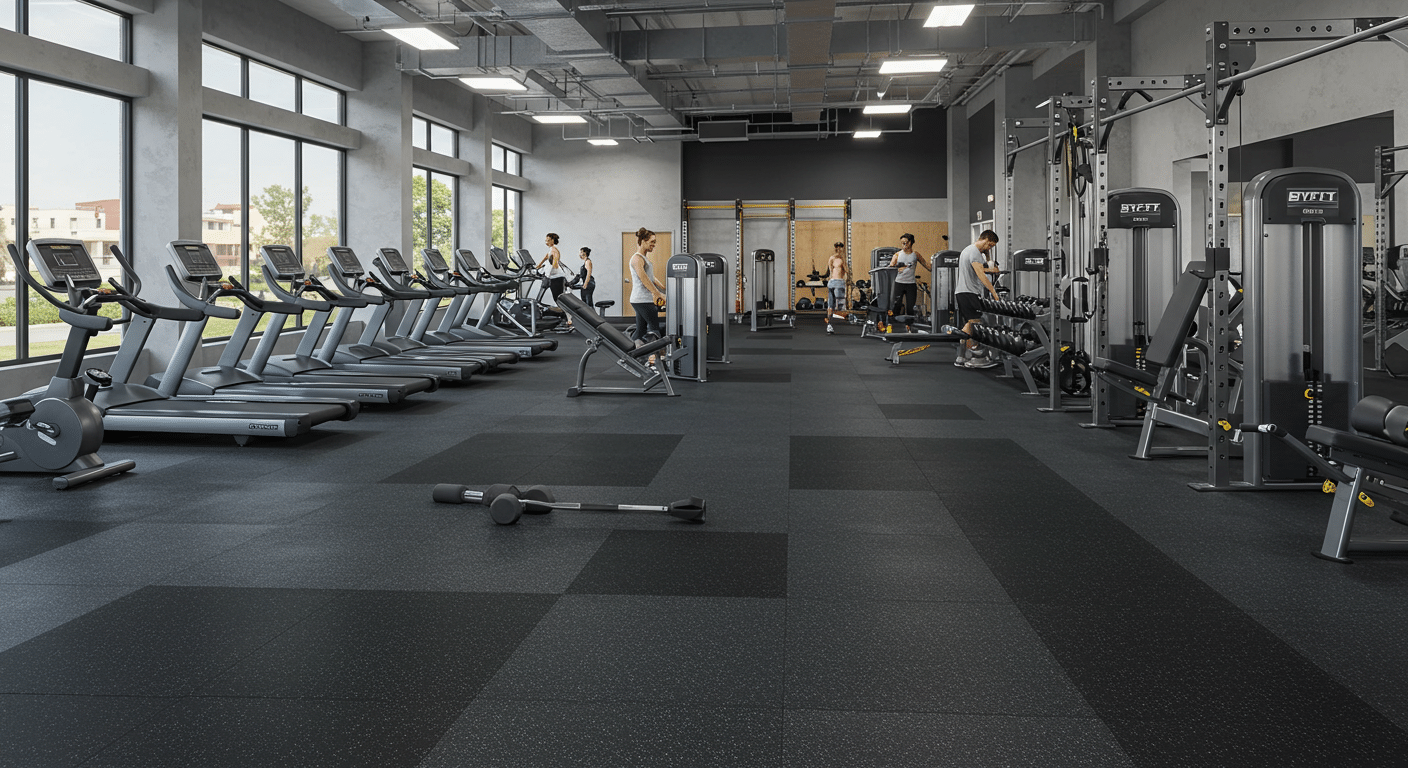Choosing the right flooring for your commercial gym can feel like navigating a minefield of options. Get it wrong, and you risk unhappy members, damaged equipment, and a costly do-over. So, what do you choose?
The best flooring for a commercial gym usually involves a mix of materials. Rubber is the star for heavy-duty areas, while turf can shine in functional training zones. However, the ideal choice depends on the specific activities and budget of your gym.
 Different Gym Flooring Types
Different Gym Flooring Types
Choosing gym flooring isn’t a one-size-fits-all scenario. You have to consider your members’ needs, so the choices will make a huge difference. Let’s break down your options so you can design a space that looks great, performs well, and keeps everyone safe.
What Are the Most Popular Types of Commercial Gym Flooring?
Imagine stepping into a gym where the weights clang loudly, echoing through the entire space. The wrong flooring choice can not only hurt the experience, but it can cause safety hazards.
The most popular choices are rubber (rolls or tiles)1, artificial turf2, and, for certain areas, vinyl or foam3. Each has pros and cons, depending on its use.
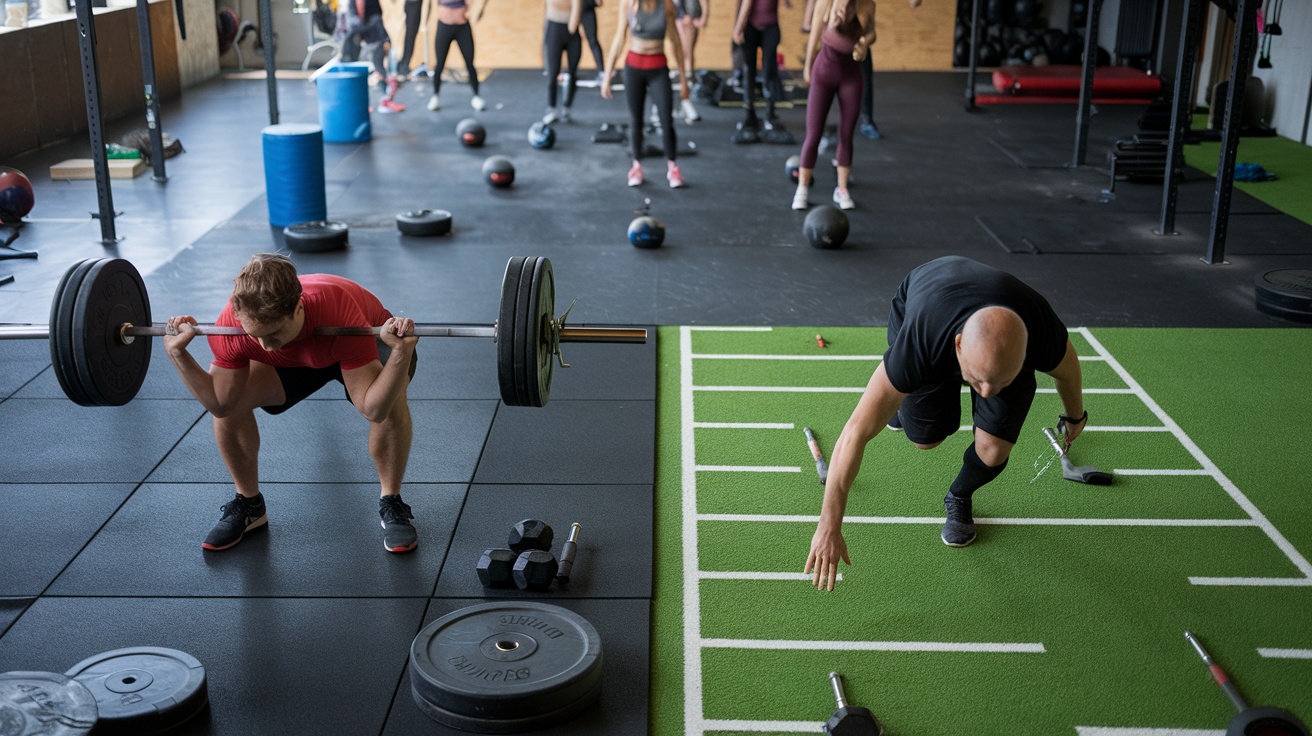 Popular Gym Floor Types
Popular Gym Floor Types
Let’s break these down a little further:
Why Is Rubber Flooring the Go-To Choice for Most Gyms?
Think of rubber flooring like the reliable workhorse of the gym world. It’s not always the prettiest, but it’s strong and handles almost anything you throw at it.
Rubber is popular because it’s durable4, shock-absorbent5, and provides good grip. It can withstand heavy weights and high-impact activities, making it ideal for most gym areas.
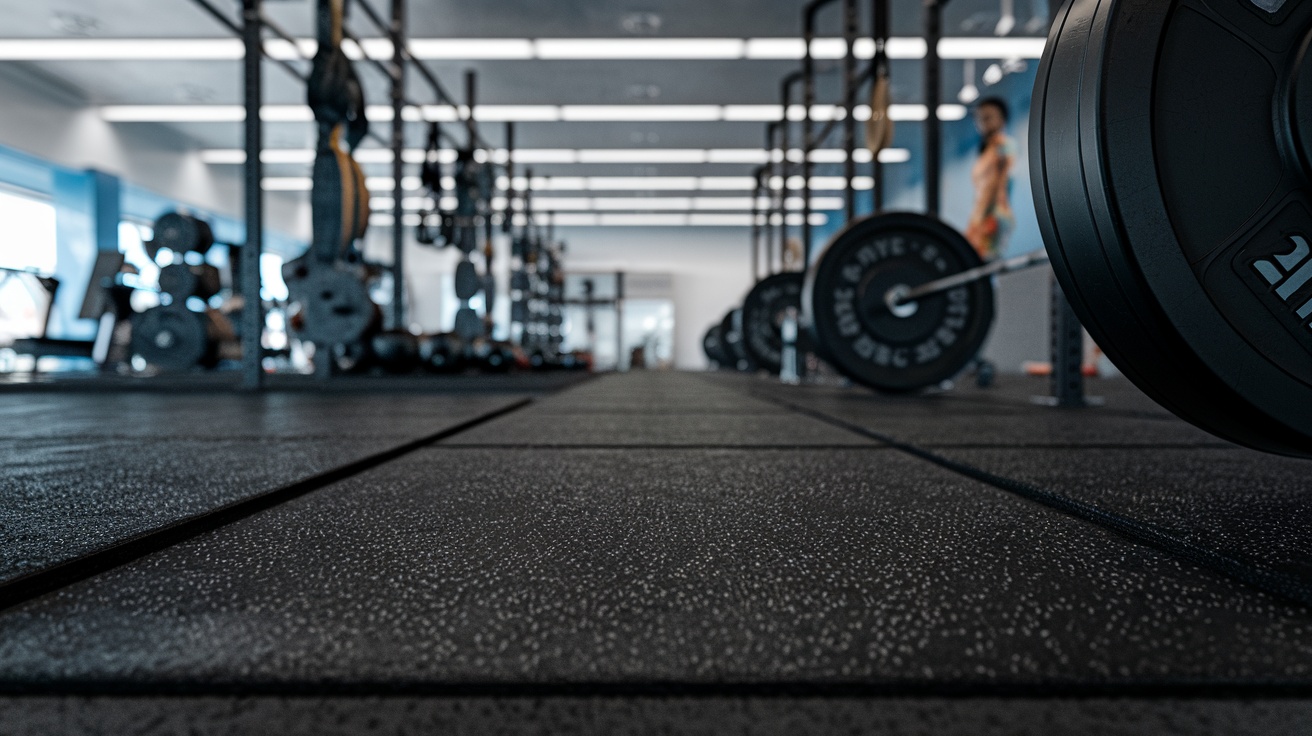 Rubber Gym Flooring
Rubber Gym Flooring
- Durability: Rubber can withstand the constant pounding of dropped weights and heavy foot traffic. It doesn’t easily tear or dent like softer materials.
- Shock Absorption: This is key for protecting joints during high-impact exercises and reducing the risk of injury. It also protects the subfloor from damage.
- Grip: Rubber provides a non-slip surface6, even when wet, which is vital for safety during workouts.
- Versatily:There are many kinds of rubber floor, and you can choose them by your needs.
| Feature | Rubber Rolls | Rubber Tiles |
|---|---|---|
| Pros | Seamless, covers large areas quickly, cost-effective | Easy DIY install, simple to replace damaged sections |
| Cons | Difficult to install alone, harder to replace sections | Seams can collect dirt, may not be as seamless |
| Best For | Large, open areas, heavy weightlifting zones | Smaller spaces, DIY projects, easy repairs |
When Should You Consider Rubber Flooring Rolls vs. Tiles?
Choosing between rolls and tiles is like deciding between a giant pizza and individual slices. Both give you the same, but the best choice depends on how you’re going to use it.
Rolls are great for covering large areas quickly and creating a seamless look. Tiles are better for smaller spaces, DIY projects, and easy repairs.
[^7] vs Tiles](https://www.byfitgear.com/wp-content/uploads/2025/02/Rubber-Rolls-vs-Tiles-scaled.jpeg) Rubber Rolls vs Tiles
Rubber Rolls vs Tiles
Think about the size of your space, your budget, and who will be doing the installation.
- Large Spaces: Rolls are generally more cost-effective for big, open areas.
- DIY Installation7: Tiles are much easier to handle and install yourself.
- Easy Repairs8: If a tile gets damaged, you only need to replace that one tile. With rolls, repairs are trickier.
- Cost:Rolls cost less,but Tiles are much easier to install yourself.
What Are the Benefits of Using Artificial Turf in a Gym?
Artificial turf is like adding a touch of the outdoors to your indoor space. It’s not just for looks, it adds some real functional benefits.
Artificial turf provides excellent traction9, cushioning, and a different feel for functional training10, agility drills11, and sled work.
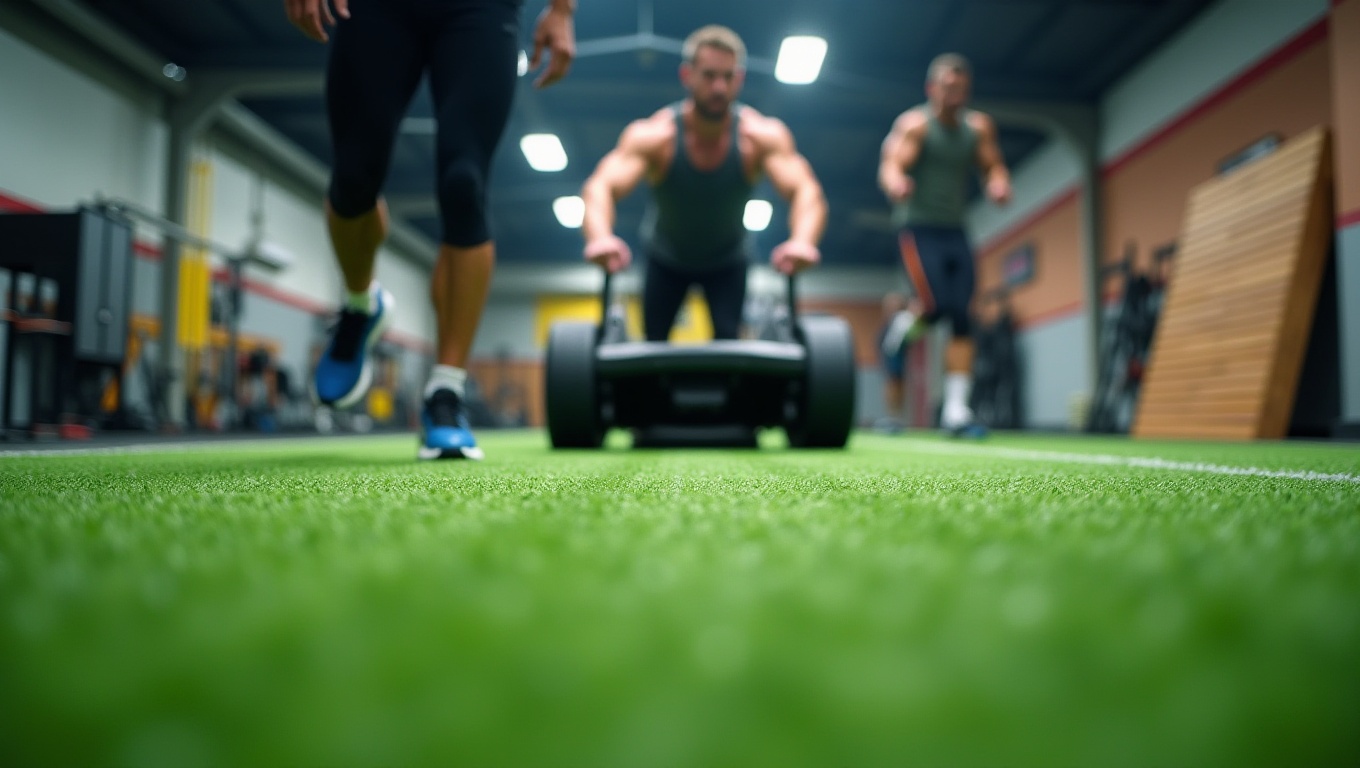 Artificial Turf in Gym
Artificial Turf in Gym
- Traction: Turf offers a superior grip for exercises that involve quick changes in direction.
- Cushioning: It’s softer than rubber, providing a more comfortable surface for floor exercises.
- Versatility: Ideal for sled pushes, agility ladders, and other functional training movements.
- Aesthetics: Turf can add a visually appealing element to your gym, creating a more inviting atmosphere.
Are There Other Options Besides Rubber and Turf? (e.g., Vinyl, Foam)
While rubber and turf are the stars, there are other options. Imagine them as the supporting cast in a play,they have smaller roles, but can be important.
Vinyl and foam can be suitable for specific areas like studios, stretching zones, or kids’ areas, but they lack the durability of rubber12 for heavy-duty use.
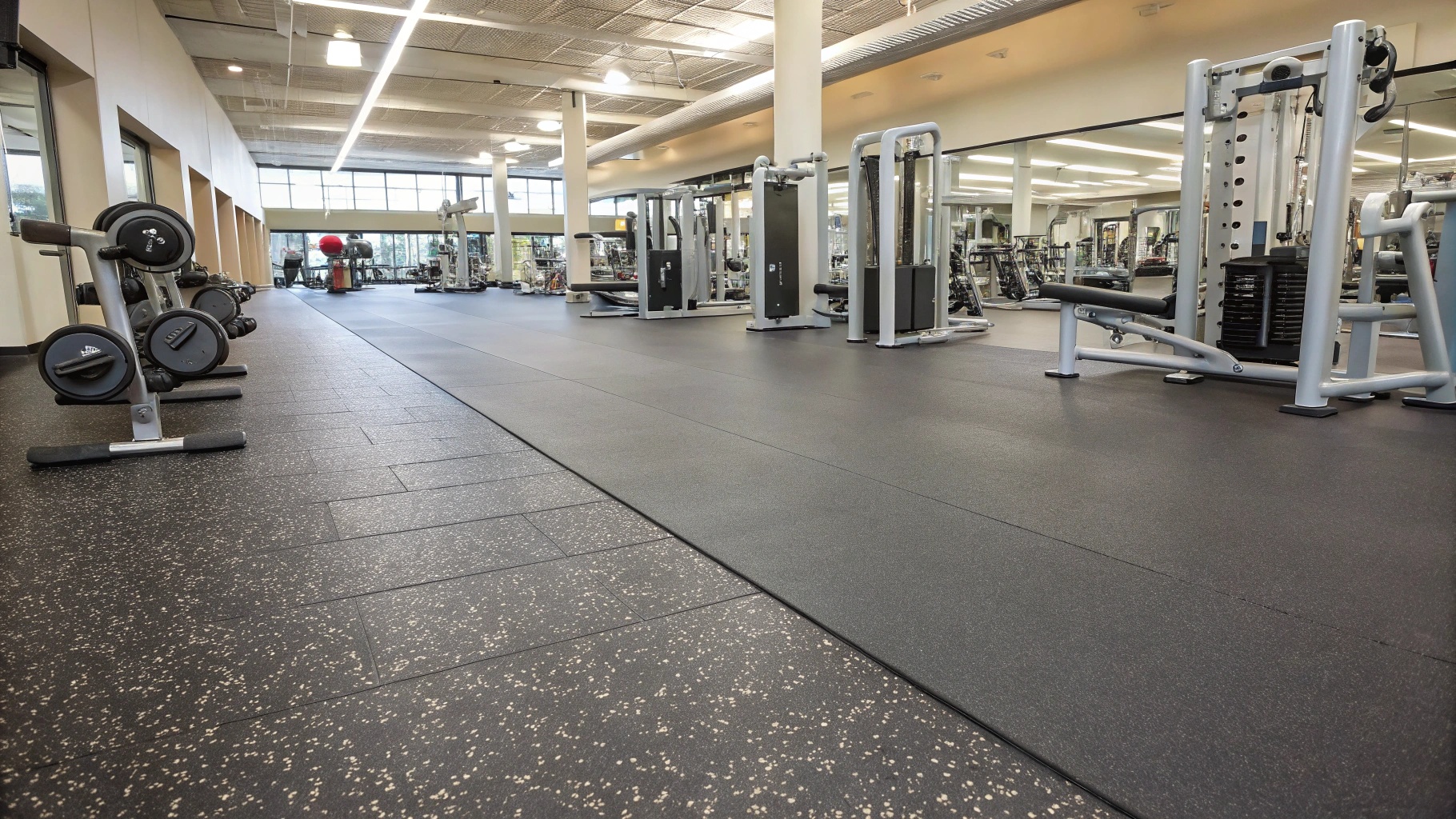 Vinyl and Foam Flooring Options
Vinyl and Foam Flooring Options
- Vinyl: Easy to clean, comes in various designs, but not ideal for high-impact activities.
- Foam: Very comfortable for stretching and bodyweight exercises, but easily damaged by weights.
- Consider Usage: These options are best for low-impact areas where comfort is a priority over heavy-duty durability.
How Do I Choose the Right Thickness for My Gym Flooring?
For general fitness, think of it like choosing a good all-around sneaker. It needs to be comfortable and supportive, but not overly bulky.
8mm to 10mm13 is usually sufficient for cardio areas, machine areas, and general exercise spaces.
8mm to 10mm is good.
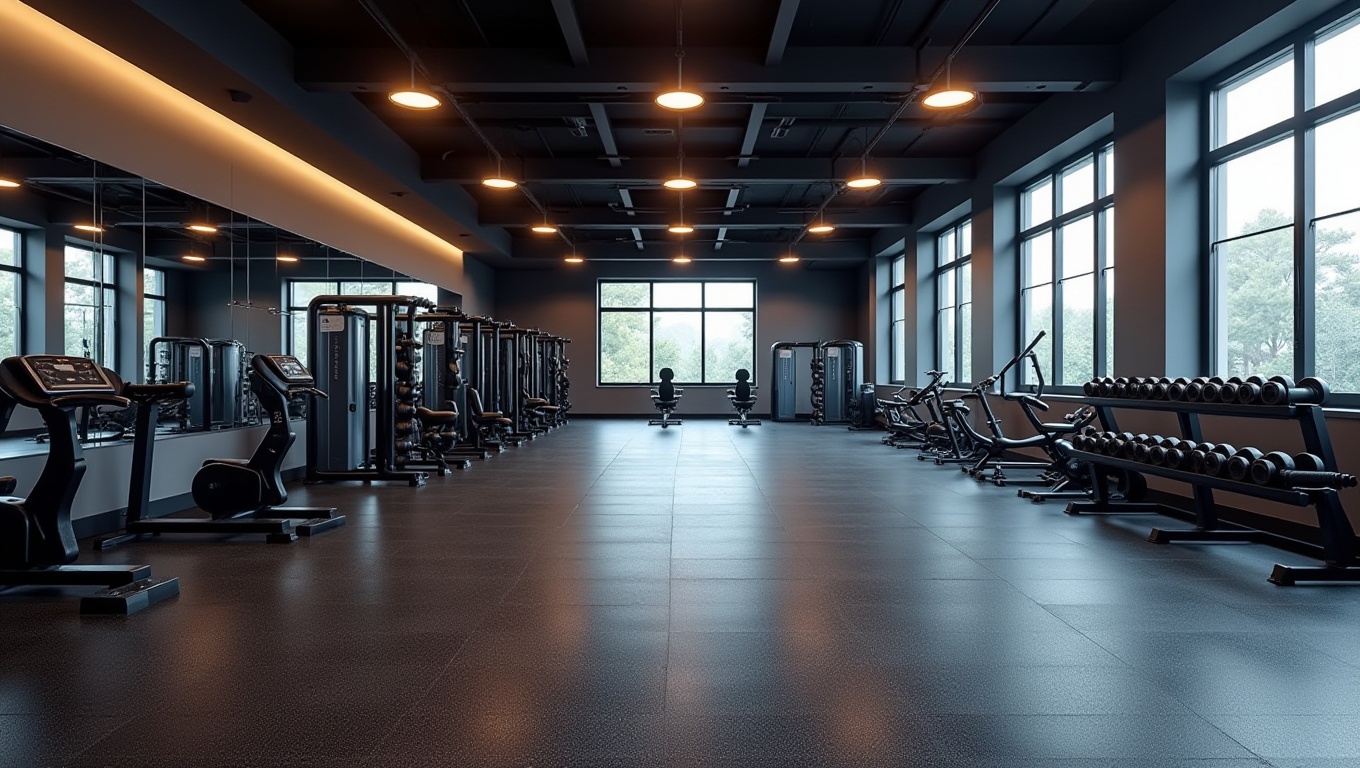 General Fitness Area Flooring
General Fitness Area Flooring
- Cost-Effective14: This thickness range provides adequate protection without the higher cost of thicker options.
- Comfortable15: Offers enough cushioning for most exercises.
- Not for Heavy Weights: It’s not designed for heavy weightlifting or dropped weights.
Do I Need Thicker Flooring for Weightlifting Zones?
For weightlifting, you need the equivalent of heavy-duty work boots. They need to be tough, and protect against serious impact.
Yes, you’ll want at least 15mm thickness16, and potentially up to 20mm or more, for areas with heavy free weights and Olympic lifting.
 Weightlifting Flooring Thickness
Weightlifting Flooring Thickness
- Impact Protection17: Thicker flooring absorbs the shock from dropped weights, protecting the subfloor and reducing noise.
- Safety18: Provides a more stable and secure surface for heavy lifting.
- Consider the Weights: The heavier the weights being used, the thicker the flooring should be.
How Does Thickness Affect Noise and Shock Absorption?
Think of thickness like the volume control on a stereo. Thicker flooring turns down the noise and absorbs more of the impact.
Thicker flooring provides better noise reduction and shock absorption, which is important for both the comfort of your members and the protection of your building.
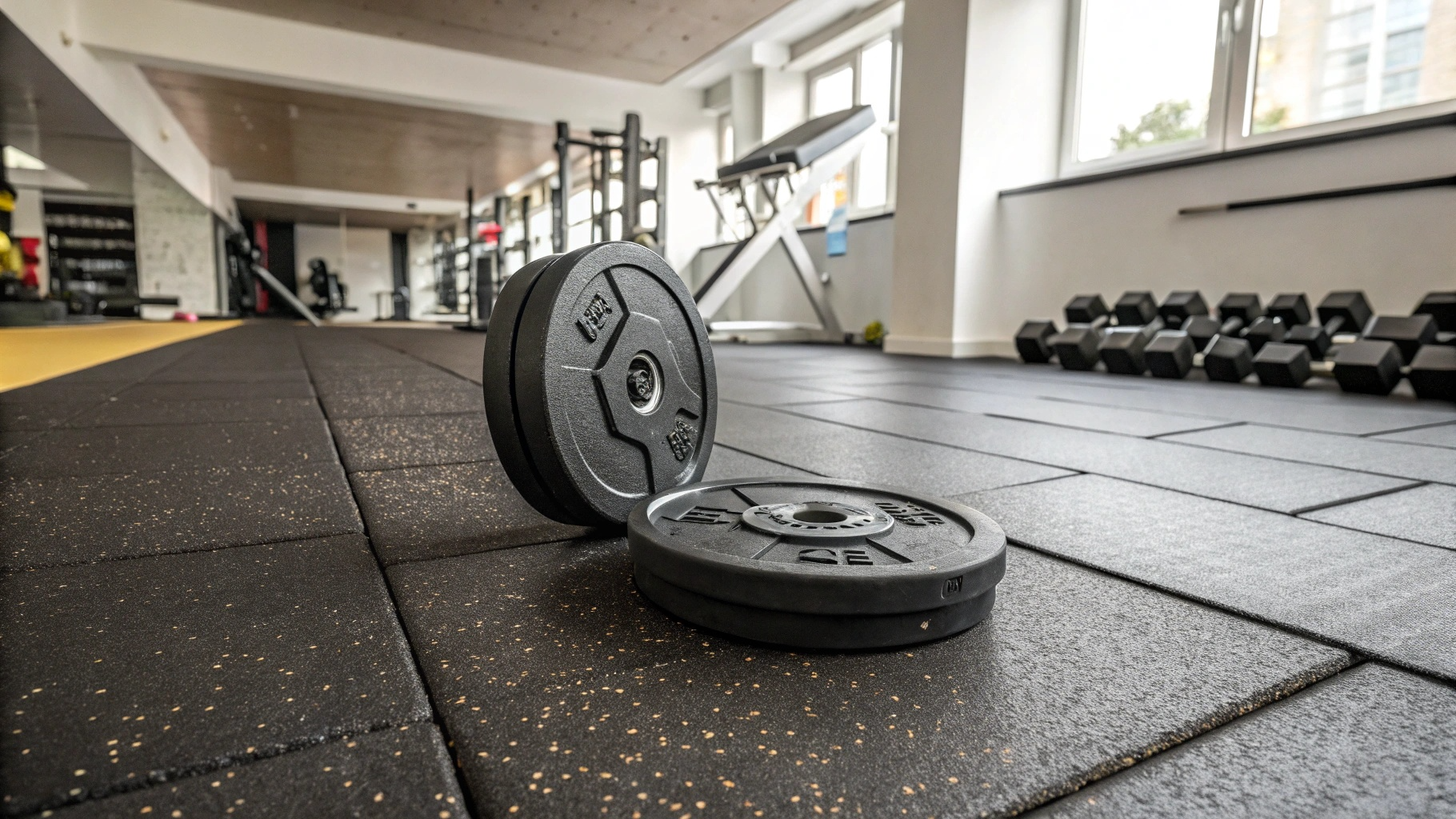 Noise and Shock Absorption in Gym Flooring
Noise and Shock Absorption in Gym Flooring
- Noise Reduction19: This is especially important in gyms located near residential areas or other noise-sensitive spaces.
- Shock Absorption: Protects joints during high-impact activities and reduces the risk of injury.
- Equipment Protection20: Helps to protect your equipment from damage caused by impact.
What’s the Best Way to Install Commercial Gym Flooring?
Installing gym flooring is like building the foundation of a house. If it’s not done right, the whole thing can fall apart.
The best installation method depends on the type of flooring, the size of the space, and your budget. Options include loose lay, tape-down, and glue-down.
 Gym Flooring Installation Methods
Gym Flooring Installation Methods
Can I Install Gym Flooring Myself (DIY)?
DIY can be tempting to save money, like fixing your own car. But just like car repair, it’s not always as easy as it looks.
Yes, some gym flooring, like interlocking tiles, is designed for easy DIY installation. However, larger projects or rolled rubber may require professional help.
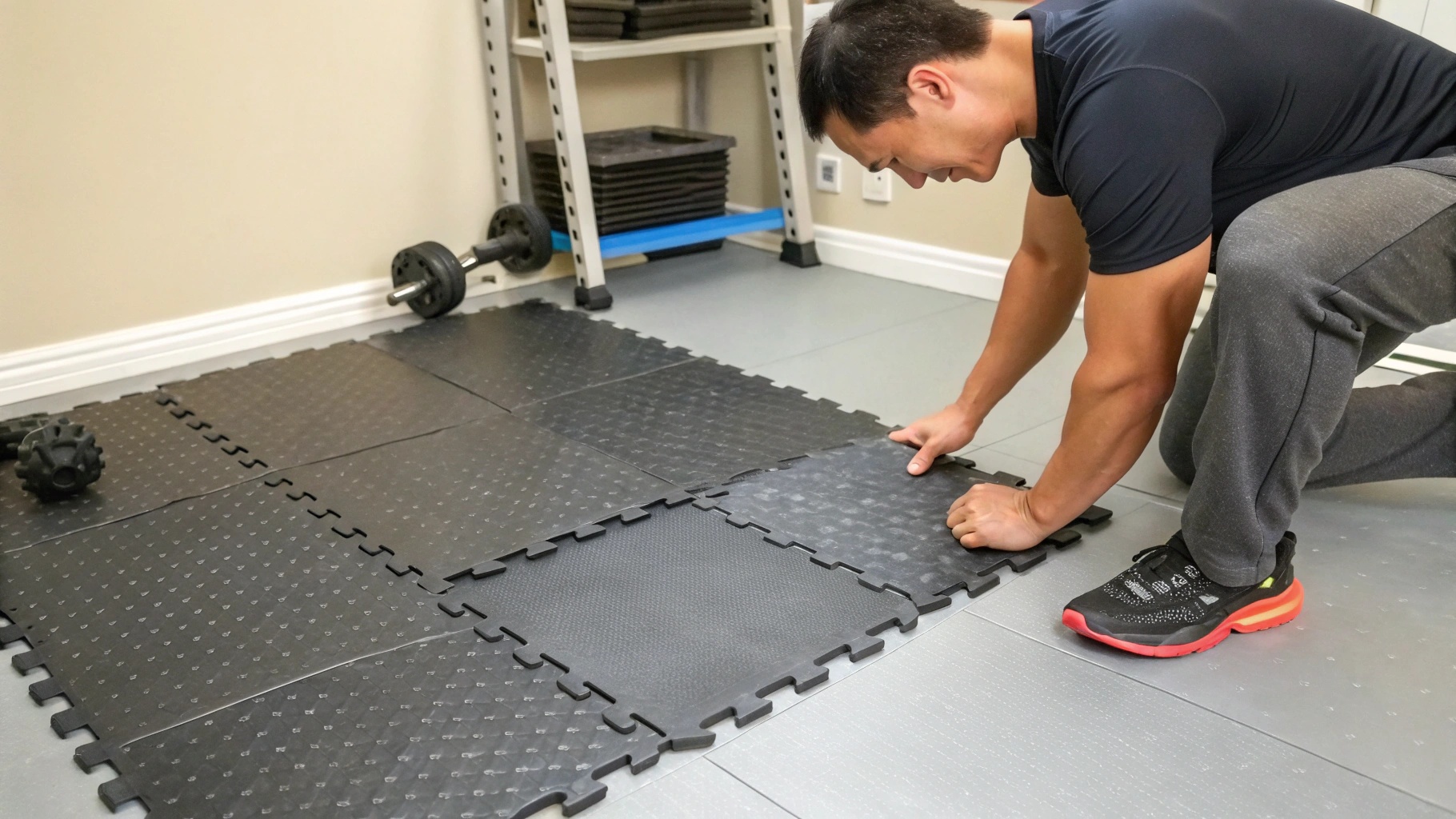 DIY Gym Flooring Installation
DIY Gym Flooring Installation
- Interlocking Tiles: These are the easiest to install yourself, as they simply snap together.
- Rolled Rubber: Requires more skill and tools, as you’ll need to cut and seam the material.
- Consider Your Skills: Be honest about your abilities. If you’re not comfortable with cutting and measuring, it’s best to hire a pro.
When Should I Hire a Professional Installer?
Hiring a pro is like bringing in a specialist mechanic. They have the tools and expertise to get the job done right.
Consider hiring a professional for large projects, rolled rubber installations, or if you want a guaranteed flawless finish.
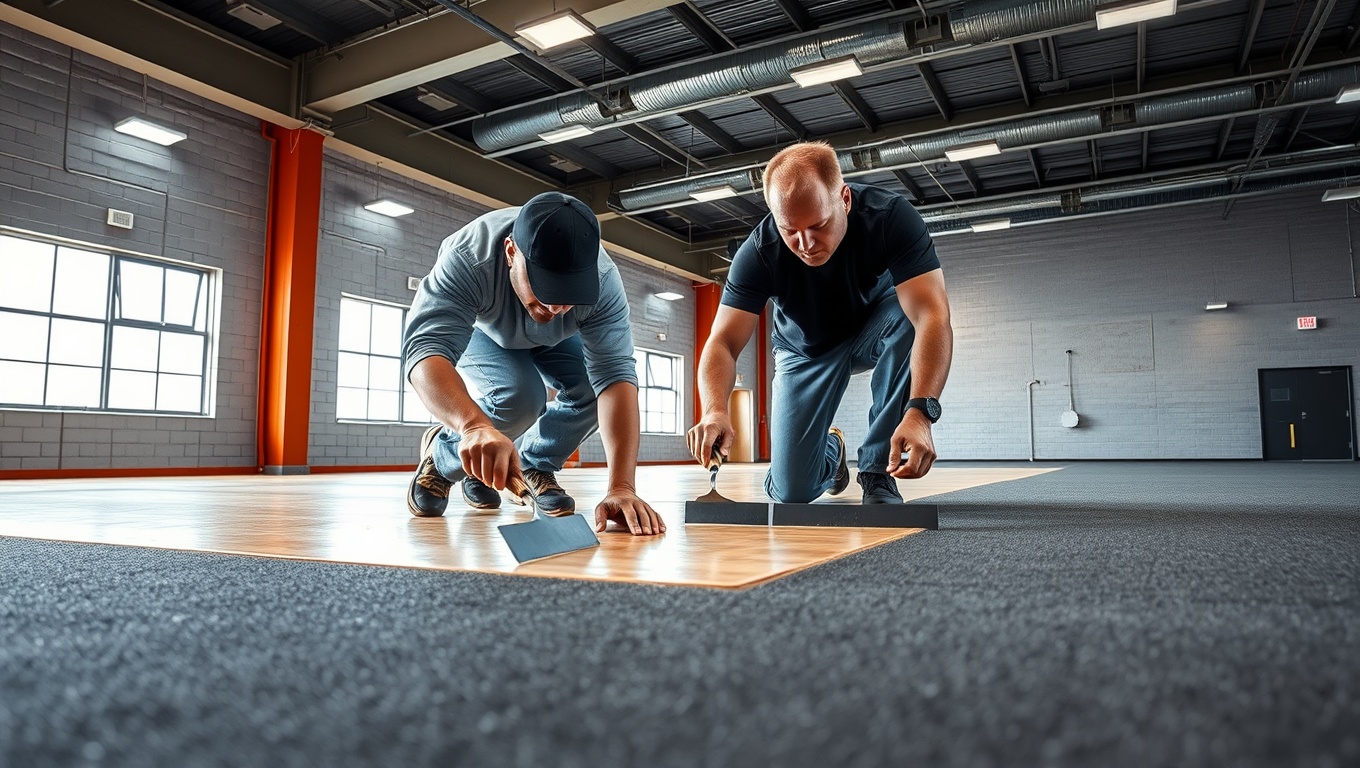 Professional Gym Flooring Installation
Professional Gym Flooring Installation
- Expertise: Professionals have the experience and tools to ensure a proper installation.
- Warranty: Many installers offer warranties on their work, giving you peace of mind.
- Time Savings: Professionals can complete the job much faster than you could on your own.
What Are the Pros and Cons of Loose Lay, Tape, and Glue-Down Installation?
Each installation method has its own set of advantages and disadvantages.
Choosing the right one is like selecting the right tool for a specific job.
Loose lay is the easiest but least secure. Tape is a good middle ground. Glue-down is the most permanent and secure, but also the most difficult to install and remove.
 Comparison of Gym Flooring Installation Methods
Comparison of Gym Flooring Installation Methods
| Method | Pros | Cons | Best For |
|---|---|---|---|
| Loose Lay | Easiest, no adhesive needed, easy to move or replace | Least secure, can shift or curl, not ideal for heavy traffic or weights | Temporary setups, small areas, low-impact zones |
| Tape | More secure than loose lay, relatively easy to install and remove | Can lose adhesion over time, not as secure as glue-down | Moderate traffic areas, semi-permanent setups |
| Glue-Down | Most secure, prevents shifting and curling, ideal for heavy traffic | Most difficult to install and remove, permanent | High-traffic areas, heavy weightlifting zones |
Conclusion
Choosing and installing the right gym flooring involves thinking about different activity zones, choosing the right thickness and picking an installation method that works for your budget. Get these choices right, and you’ll have a gym that’s safe, functional, and enjoyable for everyone.
-
Explore the advantages of rubber flooring, including durability and safety, to enhance your gym experience. ↩
-
Discover how artificial turf can enhance functionality and aesthetics in gym spaces, making workouts more enjoyable. ↩
-
Learn about the strengths and weaknesses of vinyl and foam flooring options to make an informed choice for your gym. ↩
-
Explore the advantages of durable rubber flooring to understand how it can enhance your gym experience and longevity. ↩
-
Learn about the importance of shock-absorbent flooring in protecting joints and improving workout safety. ↩
-
Discover why a non-slip surface is crucial for safety during workouts and how it can prevent injuries. ↩
-
Learn tips and tricks for DIY Installation of flooring tiles to make your project easier and more efficient. ↩
-
Discover effective methods for Easy Repairs of flooring tiles to save time and money on maintenance. ↩
-
Learn about the significance of traction in functional training and how artificial turf can provide superior grip for exercises. ↩
-
Explore how artificial turf enhances functional training, providing unique benefits for workouts and agility drills. ↩
-
Discover the advantages of using artificial turf for agility drills, enhancing performance and safety during workouts. ↩
-
Discover why rubber flooring is the go-to choice for high-impact areas, ensuring longevity and performance in fitness environments. ↩
-
Explore this link to understand why 8mm to 10mm is ideal for comfort and support in fitness spaces. ↩
-
Discover how cost-effective flooring can save money while providing necessary protection and comfort for workouts. ↩
-
Learn about the features that contribute to comfortable gym flooring, enhancing your workout experience. ↩
-
Understanding the significance of 15mm thickness can help you choose the right flooring for safety and performance in weightlifting. ↩
-
Explore how impact protection in flooring can enhance safety and performance during weightlifting sessions. ↩
-
Learn about the critical role of safety in weightlifting flooring to prevent injuries and ensure a secure lifting environment. ↩
-
Explore how noise reduction can enhance gym environments, especially in residential areas, ensuring comfort for all users. ↩
-
Discover how proper flooring can safeguard your gym equipment from damage, prolonging its lifespan and performance. ↩

